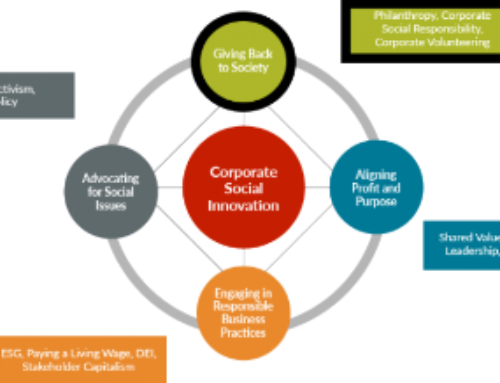“Corporate social responsibility” and “Sustainability” have taken off in ways that were only dreamed about 10 years ago. Companies are making public commitments about critical environmental and social issues. More and more companies are integrating sustainability in their strategic decision making. An increasing number of companies assess and report on the risks and opportunities related to climate change. It is encouraging that concern for corporate social responsibility and sustainability, in all of their variations, is becoming a new norm in business –whether its talking about it, reporting about it, or doing something about it.
Many players have contributed to this progress and should be applauded: the companies that have taken action, the NGOs that have publicized critical issues and supported or exposed companies’ role in them, consumers who have spoken with their purchasing decisions, and subnational and national government officials discussing effective legislation.
BUT part of that dream of 10 years ago was that we would see quicker change –in the quality of our air and water, in the volume discarded and dumped into our landfills, in the consumption patterns of our society. Outcomes that are significantly positive for the environment or society and likely scientifically necessary for our long-term survival, have yet to be realized, despite more corporate action. Why the gap?
Corporations are simply not doing enough. Corporate awareness, commitments, and initiatives are increasing in number and improving in impact. But the magnitude of the environmental and social degradation is so high that companies’ actions need to be bolder. All stakeholders need to do their part, but here the focus will be on corporations.
Let’s start with the positives. Currently, over two-thirds of Fortune 500 companies publish sustainability reports, compared with about 20% in 2010. That is an enormous increase. There have been great strides in individual companies achieving and exceeding self-imposed targets. Peruse the Environmental Leaders website and it is encouraging:
– HP operations achieved a 17.3 percent decrease in greenhouse gas emissions in 2014 compared to its 2010 baseline
– Mondelez International reduced manufacturing waste by 57 percent per metric ton of production through 2014, four times the original goal and ahead of schedule
– L’Oreal USA reduced its CO2 emissions by 57 percent in 2014 against a 2005 baseline, mostly by using renewable energy across its facilities
– Taco Bell announced that it is eliminating artificial colors and flavors, along with high-fructose corn syrup and palm oil, by the end of the year
– Pizza Hut announced that it is taking artificial flavors and colors out of its nationally available pizzas in the US by the end of July
– Walmart’s portfolio-wide cooling water management strategy has delivered 660 million gallons and over $4 million in cost savings since 2008, according to a case study published on Environmental Defense Fund’s EDF+Business blog
– Microsoft’s internal carbon fee has reduced the company’s emissions by 7.5 million metric tons of CO2e, since it was established three years ago, and saved more than $10 million per year
– Proctor & Gamble’s Tide Professional Coldwater Laundry System enables hotel facilities to reduce energy needed to heat the water in a commercial washer by as much as 75 percent and to reduce water used in a commercial washer by up to 40 percent.
You get the idea. There are great stories of corporations taking up environmental initiatives that are producing positive results.
But also consider this:
– According to point-by-point scoring report by Climate Counts, which analyzed the greenhouse gas emissions of 100 global corporations between 2005 and 2012 to determine their performance against science-based goals that seek to limit climate change to 2° Celsius (3.6° Fahrenheit), 51% are emitting unsustainable levels of CO2. Top scorers, including Unilever and Eli Lilly have successfully decoupled revenue growth and emission growth, increasing revenue while decreasing emissions. You can view the full report at http://carbonscore.climatecounts.org/
– According to the World Water Development Report (2014), global water withdrawals are projected to increase by 55% through 2050 due to growing demands from manufacturing (400%), thermal electricity generation (140%) and domestic use (130%). Furthermore, groundwater –the primary source of drinking water worldwide- is rapidly depleting. An estimated 20% of the world’s aquifers are being exploited way beyond their replenishment rate, some critically so.
– According to United Nations Environment Program (UNEP), about 280 million tons of plastic is produced globally each year and only a very small percentage is recycled. It is estimated that 10 to 20 million tons of plastic ends up in our oceans each year, costing approximately US$13 billion per year in environmental damage to marine ecosystems. Read more in its stunning report, “Valuing Plastic: The Business Case for Measuring, Managing, and Disclosing Plastic Use in the Consumer Goods Industry”, written in 2014.
Although companies deserve recognition for individual efforts, a lot more work needs to be done to create a more sustainable world. Individuals have to do their part, NGOs should keep highlighting important issues, government officials need to keep considering effective legislation, and corporations need to be bold.
1. Join ‘We Mean Business’. Commit to any or all of their initiatives that would accelerate a low carbon world. Examples include adopting a science-based emissions target, putting a price on carbon, procuring 100% energy from renewable sources. With over 100 companies globally participating, the more that join, the louder the call will be for governments to enact policies and legislation, consumers to shop wisely, and competitors and peers to join in.
2. Contact leading environmental organizations which have impactful corporate engagement programs: WWF, EDF, The Climate Group to name a few
3. Engage with leaders in your industry for ideas and opportunities for collaboration.
4. Critically examine and evaluate your business, including all of its functions and all of its stakeholders.
5. Take a look at Andrew Winston’s Big Pivot to see some strategic recommendations for more resilient companies (http://www.pivotgoals.com/)
6. Review the Sustainability Accounting Standards Board’s materiality map for your industry and proactively review and address any listed industry relevant risks (http://www.sasb.org/materiality/sasb-materiality-map/)
Be on the leading edge. Be part of the solution. Be bold.
Written by
Trina Mallik
Senior Consultant
Transitioning to Green






Leave A Comment